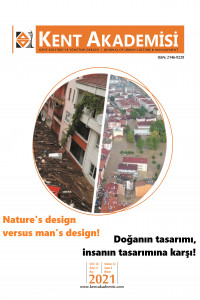Abstract
Lefkara, Kıbrıs'ın güneyinde yer alan kültürel miras açısından önemli bir köydür. Lefkara köyü, adını Lefkara veya Lefkaritika olarak bilinen geleneksel dantel yapımından alır. Bu nitelikli sanat, UNESCO Somut Olmayan Dünya Mirası Listesi'ne dahil edilmesiyle Dünya çapında tanınmıştır. Bu bağlamda, Lefkara köyü günümüzde önemli bir turistik çekim noktası haline gelmiştir. Adada yaşayanların yanı sıra farklı ülkelerden birçok turist, yerel kültürü deneyimlemek için bölgeyi ziyaret etmektedir.
Bu çalışmanın amacı kültürel miras ve turizm ilişkisini Lefkara köyü örneği üzerinden sorgulamaktır. Çalışma kapsamında, Lefkara köyü saha araştırması yoluyla gözlemlenmiş ve değerlendirmeler yapılmıştır. Bu gözlem ve değerlendirmelerden elde edilen veriler ışığında kültürel mirasın kültür turizmi açısından değerlendirilmesi için SWOT analizi yapılmıştır.
Bölgenin kültürel miras turizmi bağlamında güçlü yönleri ve fırsatları belirlenmiş, zayıf yönleri ve mevcut tehditler tartışılmıştır. Sonuç kısmında ise, bölgedeki kültürel miras turizminin gelişerek devamlılığının sağlanabilmesi adına gelecek senaryoları tartışılmış ve önerilerde bulunulmuştur.
References
- Bağışkan, Tuncer (2005). Kıbrıs'ta Osmanlı Türk Eserleri. Turkish Cypriot Association of Museum Lovers. p. 196.
- Debeş, T. (2011) Cultural tourism: a neglected dimension of tourism industry, Anatolia, 22:2, 234-251.
- Ho, P.S.Y. & McKercher, B. (2004) Managing heritage resources as tourism products, Asia Pacific Journal of Tourism Research, 9:3, 255-266
- ICOMOS (1999) International cultural tourism charter: managing tourism at places of heritage significance, https://www.icomos.org/charters/tourism_e.pdf. (accessed in 20.12.2020).
- Lussetyowati, T. (2015) Preservation and Conservation through Cultural Heritage Tourism, Case Study: Musi Riverside Palembang, Procedia - Social and Behavioral Sciences 184, pp. 401 – 406.
- McKercher, B. & Ho, P.S.Y. (2006) Assessing the Tourism Potential of Smaller Cultural and Heritage Attractions, Journal of Sustainable Tourism, 14:5, 473-488.
- Park, H. Y. (2014). Heritage Tourism. Routledge.
- Poria, Y., Butler, R. and Airey, D. (2003) The Core of Heritage Tourism, Annals of Tourism Research, Vol. 30, No. 1, pp. 238–254.
- Santa, E. D. and Tiatco, S. A. (2019) Tourism, heritage and cultural performance: Developing a modality of heritage tourism, Tourism Management Perspectives 31 (2019) 301–309.
- Smith, M. K. (2016). Issues in cultural tourism studies. ((3rd ed). Routledge).
- Timothy, D. J. (2014) Contemporary Cultural Heritage and Tourism: Development Issues and Emerging Trends, Public Archaeology, 13:1-3, 30-47.
- Timothy, D. J., & Boyd, S. W. (2006). Heritage tourism in the 21st century: Valued traditions and new perspectives. Journal of Heritage Tourism, 1(1), 1–17.
- Timothy, D. J., & Nyaupane, G. P. (2009). Cultural heritage and tourism: A regional perspective. New York: Routledge.
- URL 1. http://www.prio-cyprus-displacement.net/default.asp?id=377
- URL 2. https://ich.unesco.org/en/RL/lefkara-laces-or-lefkaritika-00255
Abstract
Lefkara village is located in the Southern part of Cyprus and it is an important district in terms of intangible and tangible cultural heritage. The village took the name from the traditional lace making (known as Lefkara or Lefkaritika). Lefkara is a traditional lace work that is recognized on the UNESCO Intangible World Heritage List for protecting the intangible cultural heritage.
The village is an important tourist attraction point. Many tourists from different countries as well as local people visit the village to experience local culture. The aim of the research is to question the relationship between cultural heritage and tourism through the case of Lefkara village.
As the method of the study, the village is observed through site survey and evaluations have been done. In the light of the data obtained from this observation, a SWOT analysis was made to evaluate the cultural heritage in terms of cultural tourism.
Within the scope of the study, strengths and opportunities of Lefkara village is discussed and also, weakness and threats is defined. As a result, future scenarios for the village is discussed and strategies is proposed to for the continuity of the cultural heritage tourism in the light of the SWOT analysis.
References
- Bağışkan, Tuncer (2005). Kıbrıs'ta Osmanlı Türk Eserleri. Turkish Cypriot Association of Museum Lovers. p. 196.
- Debeş, T. (2011) Cultural tourism: a neglected dimension of tourism industry, Anatolia, 22:2, 234-251.
- Ho, P.S.Y. & McKercher, B. (2004) Managing heritage resources as tourism products, Asia Pacific Journal of Tourism Research, 9:3, 255-266
- ICOMOS (1999) International cultural tourism charter: managing tourism at places of heritage significance, https://www.icomos.org/charters/tourism_e.pdf. (accessed in 20.12.2020).
- Lussetyowati, T. (2015) Preservation and Conservation through Cultural Heritage Tourism, Case Study: Musi Riverside Palembang, Procedia - Social and Behavioral Sciences 184, pp. 401 – 406.
- McKercher, B. & Ho, P.S.Y. (2006) Assessing the Tourism Potential of Smaller Cultural and Heritage Attractions, Journal of Sustainable Tourism, 14:5, 473-488.
- Park, H. Y. (2014). Heritage Tourism. Routledge.
- Poria, Y., Butler, R. and Airey, D. (2003) The Core of Heritage Tourism, Annals of Tourism Research, Vol. 30, No. 1, pp. 238–254.
- Santa, E. D. and Tiatco, S. A. (2019) Tourism, heritage and cultural performance: Developing a modality of heritage tourism, Tourism Management Perspectives 31 (2019) 301–309.
- Smith, M. K. (2016). Issues in cultural tourism studies. ((3rd ed). Routledge).
- Timothy, D. J. (2014) Contemporary Cultural Heritage and Tourism: Development Issues and Emerging Trends, Public Archaeology, 13:1-3, 30-47.
- Timothy, D. J., & Boyd, S. W. (2006). Heritage tourism in the 21st century: Valued traditions and new perspectives. Journal of Heritage Tourism, 1(1), 1–17.
- Timothy, D. J., & Nyaupane, G. P. (2009). Cultural heritage and tourism: A regional perspective. New York: Routledge.
- URL 1. http://www.prio-cyprus-displacement.net/default.asp?id=377
- URL 2. https://ich.unesco.org/en/RL/lefkara-laces-or-lefkaritika-00255
Details
| Primary Language | English |
|---|---|
| Subjects | Architecture |
| Journal Section | Research Article |
| Authors | |
| Publication Date | December 25, 2021 |
| Submission Date | August 16, 2021 |
| Published in Issue | Year 2021 Volume: 14 Issue: 4 |
International Refereed and Indexed Journal of Urban Culture and Management | Kent Kültürü ve Yönetimi Uluslararası Hakemli İndeksli Dergi
Information, Communication, Culture, Art and Media Services (ICAM Network) | www.icamnetwork.net
Address: Ahmet Emin Fidan Culture and Research Center, Evkaf Neigh. No: 34 Fatsa Ordu
Tel: +90452 310 20 30 Faks: +90452 310 20 30 | E-Mail: (int): info@icamnetwork.net | (TR) bilgi@icamnetwork.net

